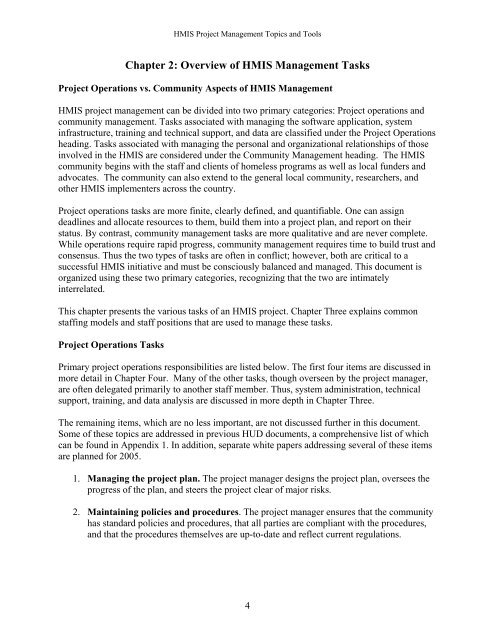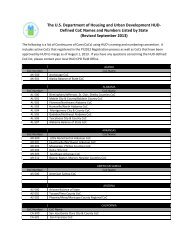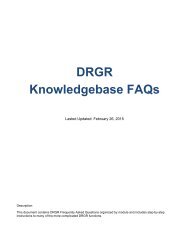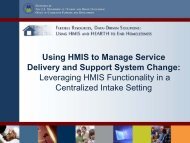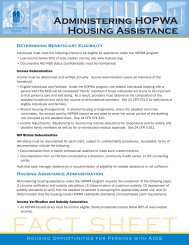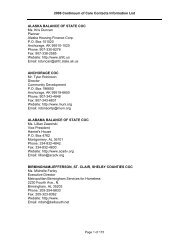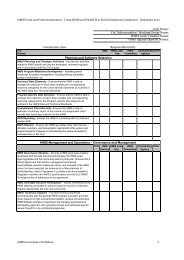HMIS Project Management Topics and Tools - OneCPD
HMIS Project Management Topics and Tools - OneCPD
HMIS Project Management Topics and Tools - OneCPD
- No tags were found...
Create successful ePaper yourself
Turn your PDF publications into a flip-book with our unique Google optimized e-Paper software.
<strong>HMIS</strong> <strong>Project</strong> <strong>Management</strong> <strong>Topics</strong> <strong>and</strong> <strong>Tools</strong>Chapter 2: Overview of <strong>HMIS</strong> <strong>Management</strong> Tasks<strong>Project</strong> Operations vs. Community Aspects of <strong>HMIS</strong> <strong>Management</strong><strong>HMIS</strong> project management can be divided into two primary categories: <strong>Project</strong> operations <strong>and</strong>community management. Tasks associated with managing the software application, systeminfrastructure, training <strong>and</strong> technical support, <strong>and</strong> data are classified under the <strong>Project</strong> Operationsheading. Tasks associated with managing the personal <strong>and</strong> organizational relationships of thoseinvolved in the <strong>HMIS</strong> are considered under the Community <strong>Management</strong> heading. The <strong>HMIS</strong>community begins with the staff <strong>and</strong> clients of homeless programs as well as local funders <strong>and</strong>advocates. The community can also extend to the general local community, researchers, <strong>and</strong>other <strong>HMIS</strong> implementers across the country.<strong>Project</strong> operations tasks are more finite, clearly defined, <strong>and</strong> quantifiable. One can assigndeadlines <strong>and</strong> allocate resources to them, build them into a project plan, <strong>and</strong> report on theirstatus. By contrast, community management tasks are more qualitative <strong>and</strong> are never complete.While operations require rapid progress, community management requires time to build trust <strong>and</strong>consensus. Thus the two types of tasks are often in conflict; however, both are critical to asuccessful <strong>HMIS</strong> initiative <strong>and</strong> must be consciously balanced <strong>and</strong> managed. This document isorganized using these two primary categories, recognizing that the two are intimatelyinterrelated.This chapter presents the various tasks of an <strong>HMIS</strong> project. Chapter Three explains commonstaffing models <strong>and</strong> staff positions that are used to manage these tasks.<strong>Project</strong> Operations TasksPrimary project operations responsibilities are listed below. The first four items are discussed inmore detail in Chapter Four. Many of the other tasks, though overseen by the project manager,are often delegated primarily to another staff member. Thus, system administration, technicalsupport, training, <strong>and</strong> data analysis are discussed in more depth in Chapter Three.The remaining items, which are no less important, are not discussed further in this document.Some of these topics are addressed in previous HUD documents, a comprehensive list of whichcan be found in Appendix 1. In addition, separate white papers addressing several of these itemsare planned for 2005.1. Managing the project plan. The project manager designs the project plan, oversees theprogress of the plan, <strong>and</strong> steers the project clear of major risks.2. Maintaining policies <strong>and</strong> procedures. The project manager ensures that the communityhas st<strong>and</strong>ard policies <strong>and</strong> procedures, that all parties are compliant with the procedures,<strong>and</strong> that the procedures themselves are up-to-date <strong>and</strong> reflect current regulations.4


